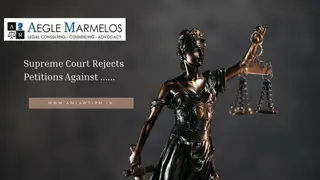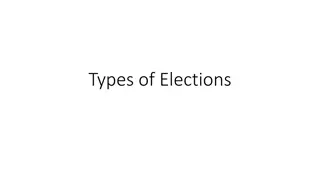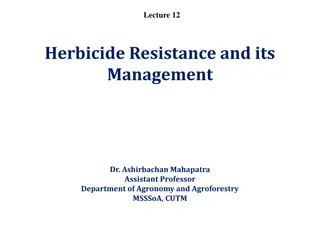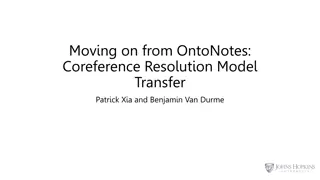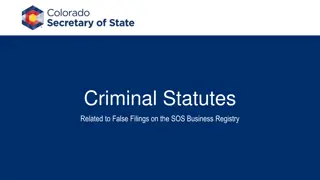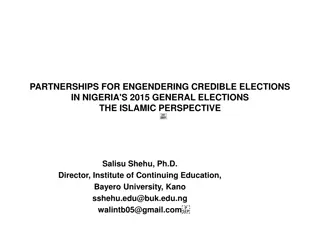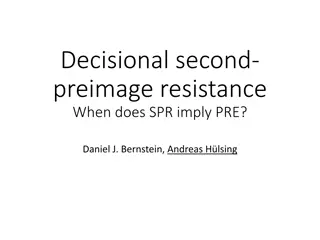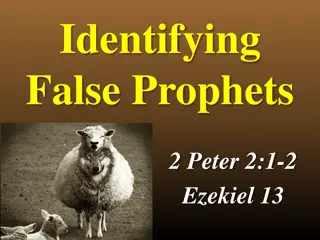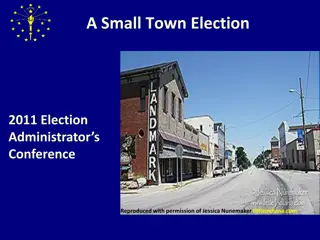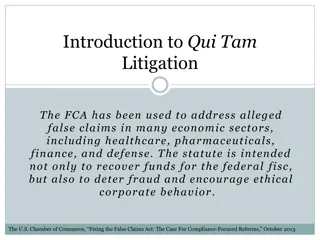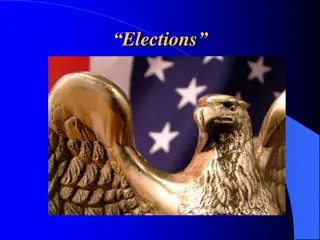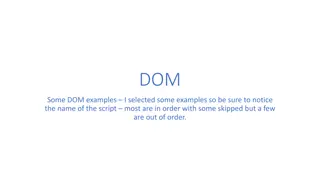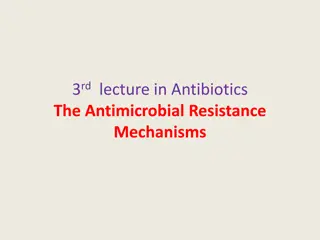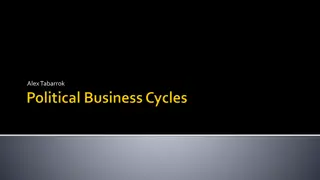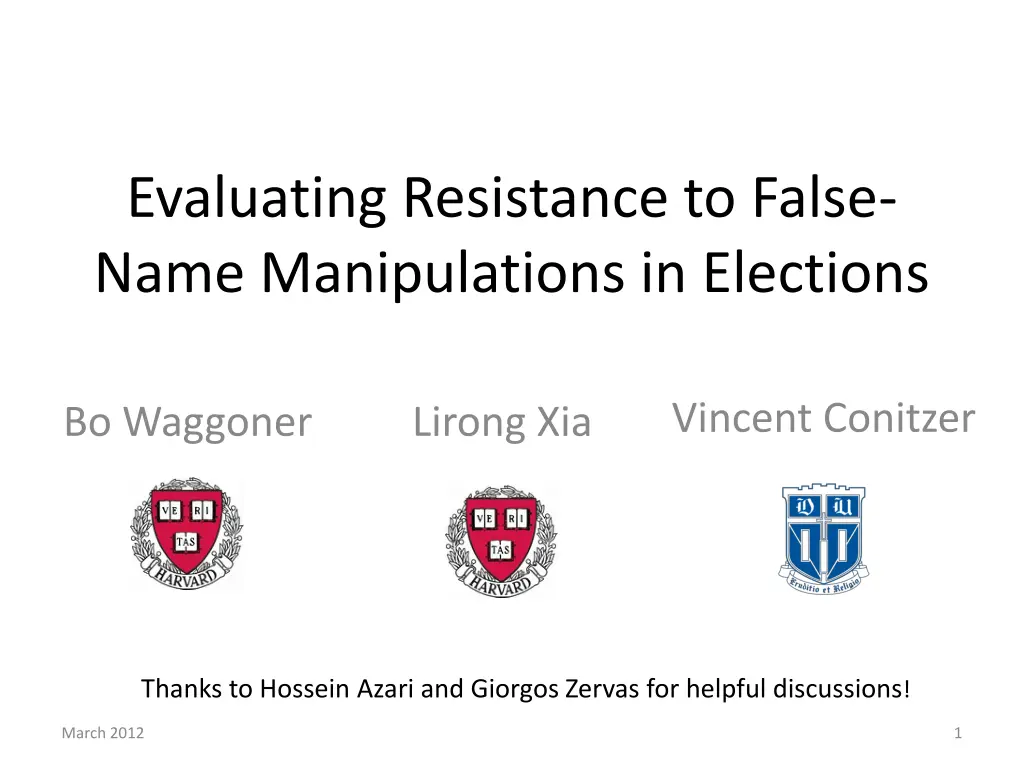
Evaluating Resistance to False Name Manipulations in Elections
This research paper discusses evaluating resistance to false-name manipulations in elections, focusing on methods to limit false names, prevent strategic behaviors, and address challenges like multiple voting. The study explores models, methods, and outcomes in the context of voting mechanisms and voter identities.
Download Presentation

Please find below an Image/Link to download the presentation.
The content on the website is provided AS IS for your information and personal use only. It may not be sold, licensed, or shared on other websites without obtaining consent from the author. If you encounter any issues during the download, it is possible that the publisher has removed the file from their server.
You are allowed to download the files provided on this website for personal or commercial use, subject to the condition that they are used lawfully. All files are the property of their respective owners.
The content on the website is provided AS IS for your information and personal use only. It may not be sold, licensed, or shared on other websites without obtaining consent from the author.
E N D
Presentation Transcript
Evaluating Resistance to False- Name Manipulations in Elections Vincent Conitzer Bo Waggoner Lirong Xia Thanks to Hossein Azari and Giorgos Zervas for helpful discussions! March 2012 1
Outline Background and motivation: Why study elections in which we expect false-name votes? Our model How to select a false-name-limiting method? How to evaluate the election outcome? Recap and future work March 2012 2
Motivating Challenge: Poll customers about a potential product A B C March 2012 3
Preventing strategic behavior Deter or hinder misreporting Restricted settings (e.g., single-peaked preferences) Use computational complexity March 2012 4
False-name manipulation False-name-proof voting mechanisms? Extremely negative result for voting [C., WINE 08] Restricting to single-peaked preferences does not help much [Todo, Iwasaki, Yokoo, AAMAS 11] Assume creating additional identifiers comes at a cost [Wagman & C., AAAI 08] Verify some of the identities [C., TARK 07] Use social network structure [C., Immorlica, Letchford, Munagala, Wagman, WINE 10] Overview article [C., Yokoo, AIMag 2010] Common factor: false-name-proof March 2012 6
Lets at least put up some obstacles 140.247.232.88 jmhzdszx@sharklasers.com Issues: 1. Some still vote multiple times 2. Some don t vote at all March 2012 7
Approach Suppose we can experimentally determine how many identities voters tend to use for each method. 140.247.232.88 jmhzdszx@sharklasers.com 80 80 80 % of people 60 60 60 40 40 40 20 20 20 0 0 0 0 1 2 3 4 5 0 1 # of votes 2 3 4 5 0 1 2 3 4 5 March 2012 March 2012 8 8
Outline Background and motivation: Why study elections in which we expect false-name votes? Our model How to select a false-name-limiting method? How to evaluate the election outcome? Recap and future work March 2012 9
Model For each false-name-limiting method, take the individual vote distribution ? as given Suppose votes are drawn i.i.d. 0.8 Probability 0.6 0.4 0.2 0 0 1 2 3 4 5 # of votes March 2012 10
Model Single-peaked preferences (here: two alternatives) Supporters Supporters Votes Cast Votes Cast Observed Observed ?? ?? ?? ?? False- name- limiting method ?? ?? ?? March 2012 March 2012 11 11
Outline Background and motivation: Why study elections in which we expect false-name votes? Our model How to select a false-name-limiting method? How to evaluate the election outcome? Recap and future work March 2012 12
Example Is the choice always obvious? Individual vote distribution for 2010 U.S. midterm Congressional elections: Actual (in-person) Hypothetical (online) 80 percent of eligible voters percent of eligible voters 80 60 60 40 40 20 20 0 0 0 1 Votes cast 2 3 4 5 0 1 Votes cast 2 3 4 1000 March 2012 13
Problem statement voters ??> ?? ?? ?? > ? Pr[correct | ?1] Pr[correct | ?2] (Pr[correct ] = Pr[??> ??]) March 2012 14
Our results We show: which of ?1 and ?2 is preferable as elections grow large Setting: sequence of growing supporter profiles (??,??) where: 1. ?? ?? ?( ?)(elections are close ) 2. ?? ?? ? 1(but not dead even ) March 2012 15
Selecting a false-name-limiting method Theorem 1. Suppose ?1 ?1>?2 ?2. Then eventually Pr[correct |?1] > Pr[correct |?2]. For large enough elections, the ratio of mean to standard deviation is all that matters. March 2012 16
Selecting a false-name-limiting method Intuition. Distributions approach Gaussians Pr[correct] = Pr[?? > ??] = Pr[?? - ??> 0] approaches ? ? ?? ?? . ? ?2 ?2 ?1 ?1 March 2012 17
Question 1 Recap voters ??> ?? ?? ?? ?? ?? ?? ?? Takeaway: choose highest ratio! Inspiration for new methods? March 2012 18
Outline Background and motivation: Why study elections in which we expect false-name votes? Our model How to select a false-name-limiting method? How to evaluate the election outcome? Recap and future work March 2012 19
Analyzing election results Observe votes ??> ?? One approach: Bayesian Prior Evidence Posterior Pr[??,??] ( ??, ??) Pr[??,?? | ??, ??] Requires a prior, which may be costly/impossible to obtain biased or open to manipulation Our approach: statistical hypothesis testing March 2012 20
Statistical hypothesis testing Observed Observed ??> ?? Conclusion Conclusion ??> ?? ?? ? test statistic Null hypothesis Null hypothesis ??= ?? ?? Pr[? ?] p-value March 2012 21
Statistical hypothesis testing Observed Observed Conclusion Conclusion ??> ?? ?? ? Null hypothesis Null hypothesis ??= ?? p p- -value value Pr[? > ?] ?? observed is not unlikely under null hypothesis observed is unlikely under null hypothesis accept null p-value > .05 reject null p-value < .05 March 2012 22
Complication Null hypothesis: ??= ??= 1,2,3,4, We can compute a p-value for each one. p-value Reject (max-p < R) ?? Accept (min-p > R) p-value ?? Unclear p-value ?? March 2012 23
Our statistical test Procedure: 1. Select significance level R (e.g. 0.05). 2. Observe votes ??> ?? . 3. Compute ?. 4. If max ??=???-value < R, reject. 5. If min ??=???-value > R, don t reject. 6. Else, inconclusive whether to reject or not. March 2012 March 2012 24 24
Example and picking a test statistic Supporters Supporters ?? (?) ?? Observed Observed 92 = ?? False-name- limiting method M ?? (?) 80 = ?? ?( ??, ??) = ? March 2012 25
Selecting a test statistic ??= 92, ??= 80. Observed: ? = ?? ??= 12 Difference rule: ?? ?? ? ? = 0.07 Percent rule: ?? ?? ?? 12 ? = = General form: 172? (Adjusted margin of victory) March 2012 26
Test statistics that fail Theorem 2. Let the adjusted margin of victory be ? = ?? . Then 1. For any ? < 0.5, max-p = : we can never be sure to reject. (Type 2 errors) 2. For any ? > 0.5, min-p = 0: we can never be sure to accept . (Type 1 errors) ?? ?? March 2012 27
Test statistics for an election p-value March 2012 28
The right test statistic Theorem 3. Let the adjusted margin of victory formula be ?? ?? ?0.5 . Then 1. For a large enough ?, we will reject. (Declare the outcome correct .) 2. For a small enough ?, we will not reject. (Declare the outcome inconclusive .) ? = March 2012 29
Test statistics for an election p-value March 2012 30
We can usually tell whether to reject or not March 2012 31
Use this test! 1. Select significance level R (e.g. 0.05). 2. Observe votes ??> ?? . ?? ?? ?0.5. 4. If max ??=???-value < R, reject: high confidence. 5. If min ??=???-value > R, don t: low confidence. 6. Else, inconclusive whether to reject or not. (rare!) 3. Compute ? = March 2012 32
Outline Background and motivation: Why study elections in which we expect false-name votes? Our model How to select a false-name-limiting method? How to evaluate the election outcome? Recap and future work March 2012 33
Summary Model: take ? as given, draw votes i.i.d. How to select a false-name-limiting method? A: Pick the method with the highest ? ? . How to evaluate the election outcome? A: Statistical significance test with ? = using max p-value and min p-value. ?? ?? ?0.5 March 2012 34
Future Work Single-peaked preferences (done) Application to real-world problems Other models or weaker assumptions How to actually produce distributions ?? Experimentally Model agents and utilities Thanks! March 2012 35


